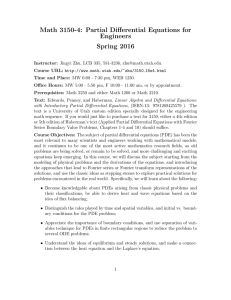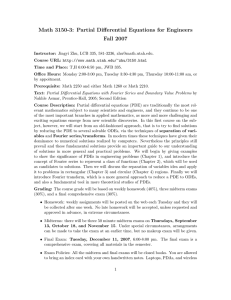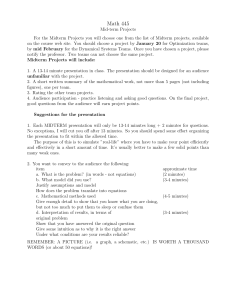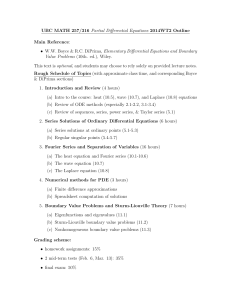Math 3150-3: Partial Differential Equations for Engineers Spring 2016
advertisement
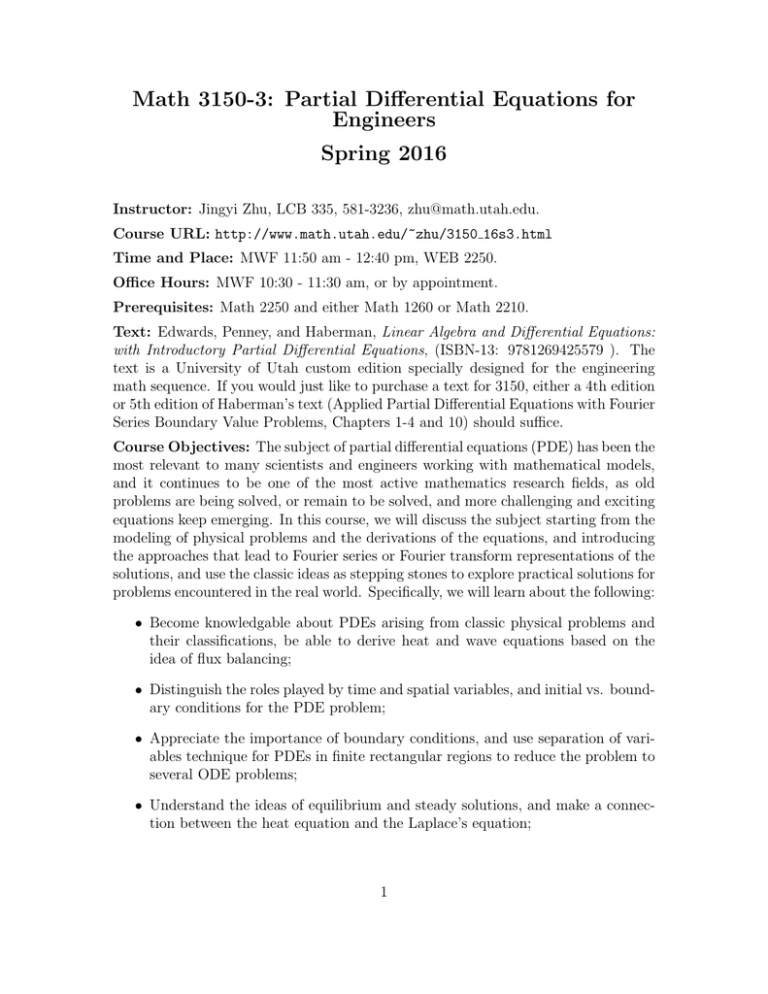
Math 3150-3: Partial Differential Equations for Engineers Spring 2016 Instructor: Jingyi Zhu, LCB 335, 581-3236, zhu@math.utah.edu. Course URL: http://www.math.utah.edu/~zhu/3150 16s3.html Time and Place: MWF 11:50 am - 12:40 pm, WEB 2250. Office Hours: MWF 10:30 - 11:30 am, or by appointment. Prerequisites: Math 2250 and either Math 1260 or Math 2210. Text: Edwards, Penney, and Haberman, Linear Algebra and Differential Equations: with Introductory Partial Differential Equations, (ISBN-13: 9781269425579 ). The text is a University of Utah custom edition specially designed for the engineering math sequence. If you would just like to purchase a text for 3150, either a 4th edition or 5th edition of Haberman’s text (Applied Partial Differential Equations with Fourier Series Boundary Value Problems, Chapters 1-4 and 10) should suffice. Course Objectives: The subject of partial differential equations (PDE) has been the most relevant to many scientists and engineers working with mathematical models, and it continues to be one of the most active mathematics research fields, as old problems are being solved, or remain to be solved, and more challenging and exciting equations keep emerging. In this course, we will discuss the subject starting from the modeling of physical problems and the derivations of the equations, and introducing the approaches that lead to Fourier series or Fourier transform representations of the solutions, and use the classic ideas as stepping stones to explore practical solutions for problems encountered in the real world. Specifically, we will learn about the following: • Become knowledgable about PDEs arising from classic physical problems and their classifications, be able to derive heat and wave equations based on the idea of flux balancing; • Distinguish the roles played by time and spatial variables, and initial vs. boundary conditions for the PDE problem; • Appreciate the importance of boundary conditions, and use separation of variables technique for PDEs in finite rectangular regions to reduce the problem to several ODE problems; • Understand the ideas of equilibrium and steady solutions, and make a connection between the heat equation and the Laplace’s equation; 1 • Learn about representing functions by Fourier series, as candidates for PDE solutions, and furthermore understand the principle behind the formulas for the coefficients; • Understand the concept of series convergence and its relevance to PDE solutions; • Solve the one-dimensional initial/boundary value problems for the wave equation and heat equation in bounded regions; • Understand the idea of Fourier transform in conversion of a PDE problem involving unbounded regions; • Be familiar with the technique of Fourier transform and use it to solve PDEs in unbounded regions . Grading: The course grade will be based on weekly homework (20%), weekly quizzes (20%), two midterm exams (30%), and a final comprehensive exam (30%). • Homework: Weekly assignments will be posted on Canvas each Monday, and collected on the following Monday. No late homework is accepted, unless it has been requested and approved in advance for extreme circumstances. • Weekly Quizzes: On each Wednesday except the midterm weeks, there will be a 15-minute quiz. The problems are more conceptual and we are more concerned with ideas rather than final answers. Those quizzes are closed book and closed notes. • Midterms: There will be two 50-minute midterm exams on Fridays, February 12, and March 25. These midterm exams are not comprehensive. Under special circumstances, arrangements can be made to take the exam at an earlier time, but no makeup exam will be arranged. • Final Exam: Tuesday, May 3, 2016, 10:30 am - 12:30 pm, in our regular classroom. The final exam is a comprehensive exam, covering all materials in the semester. • Exam Policies: All the midterm and final exams will be closed book exams. You are allowed to bring a 5 × 7 index card with your own handwritten notes. Laptops, tablets, and other wireless devices are not allowed in exams. Withdrawals: Last day to register is Jan. 17. Last day to drop class is Jan. 22. Until March 4 you can withdraw from class with no approval at all. After that date you must petition your dean’s office to be allowed to withdraw. Tutoring Center: Free tutoring is available in the T. Benny Rushing Mathematics Center, located between JWB and LCB. It opens M-Th 8:00 am - 8:00 pm, Fri 8:00 2 Table 1: Grading Scales %-age 90-100 85-89 80-84 75-79 70-74 65-69 60-64 55-59 45-54 0-44 Grade A AB+ B BC+ C CD E am - 6:00 pm. ADA Statement: The American with Disabilities Act requires that reasonable accommodations be provided for students with physical, sensory, cognitive, systemic, learning, and psychiatric disabilities. Please contact me at the beginning of the semester to discuss any such accommodations for the course. Tentative Schedule Date Jan 11, 13 and 15 Jan 20 and 22 Jan 25, 27 and 29 Feb 1, 3 and 5 Feb 8, 10 and 12 Feb 17 and 19 Feb 22, 24 and 26 Feb 29, Mar 2 and 4 Mar 7, 9 and 11 Mar 14 - 18 Mar 21, 23 and 25 Mar 28 and 30, Apr 1 Apr 4, 6 and 8 Apr 11, 13 and 15 Apr 18, 20 and 22 Apr 25 Section 12.1-2 12.3-4 12.5, 13.1 13.2-3 13.4 13.5, 14.1-2 14.3-4 14.5 15.1-3 15.4-5 15.5-6 16.1-2 16.3-4 16.4-5 Topic Introduction to PDEs, Derivation of Heat Equation Boundary Conditions, Equilibrium Distribution Heat Equation in 2 or 3 Dimensions Method of Separation of Variables, Temperature in a Rod Other Boundary Conditions, Midterm 1 Laplace’s Equation, Fourier Series, Convergence Cosine and Sine Series, Term-by-Term Differentiation Term-by-Term Integration, Inner Product Spaces Introduction to Wave Equation, Vibrating String Spring Break Vibrating String and Membrane, Midterm 2 Wave Equation in 2-Dimensions Heat Equation on an Infinite Domain Fourier Transform Pair Fourier Transform and the Heat Equation Course Review 3
